Analysis of Leadership and Operations Management at ASDA
VerifiedAdded on 2023/01/17
|15
|4668
|65
Report
AI Summary
This report provides a comprehensive analysis of leadership and operations management within the context of ASDA, a British retail supermarket. It begins by differentiating between the characteristics and roles of leaders and managers, highlighting their distinct approaches to achieving organizational goals. The report then delves into the practical application of leadership and management in various situational contexts, such as labor turnover, conflict resolution, and sales reduction, emphasizing the specific functions leaders and managers perform in each scenario. Furthermore, the report explores different leadership theories and models, including situational leadership, system leadership, and the contingency approach, and discusses their relevance to ASDA's operational environment. The report also examines key approaches to operations management, the roles of leaders and managers in this context, and the importance and value of effective operations management for achieving business objectives. Finally, the report identifies factors impacting operational management and decision-making within the ASDA environment.
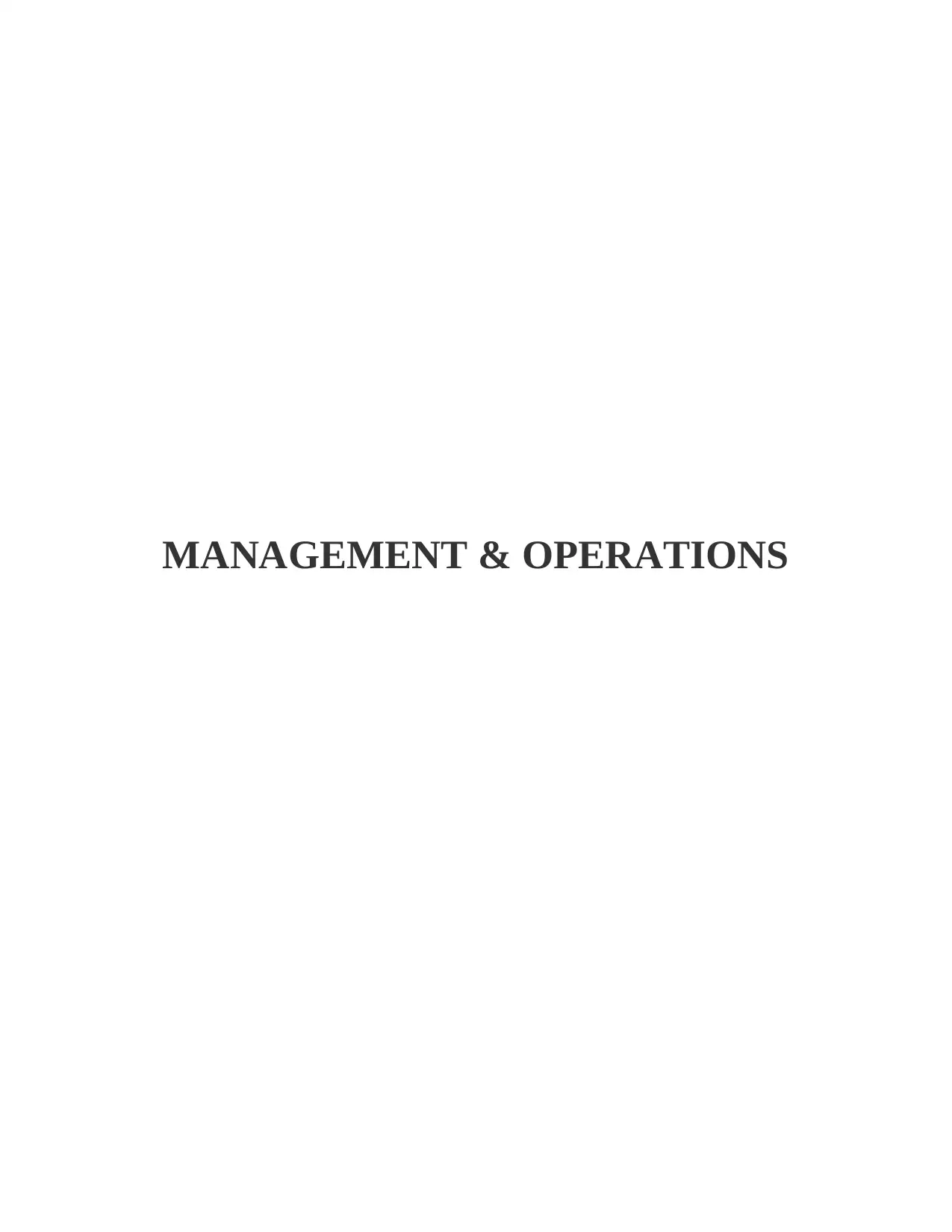
MANAGEMENT & OPERATIONS
Paraphrase This Document
Need a fresh take? Get an instant paraphrase of this document with our AI Paraphraser
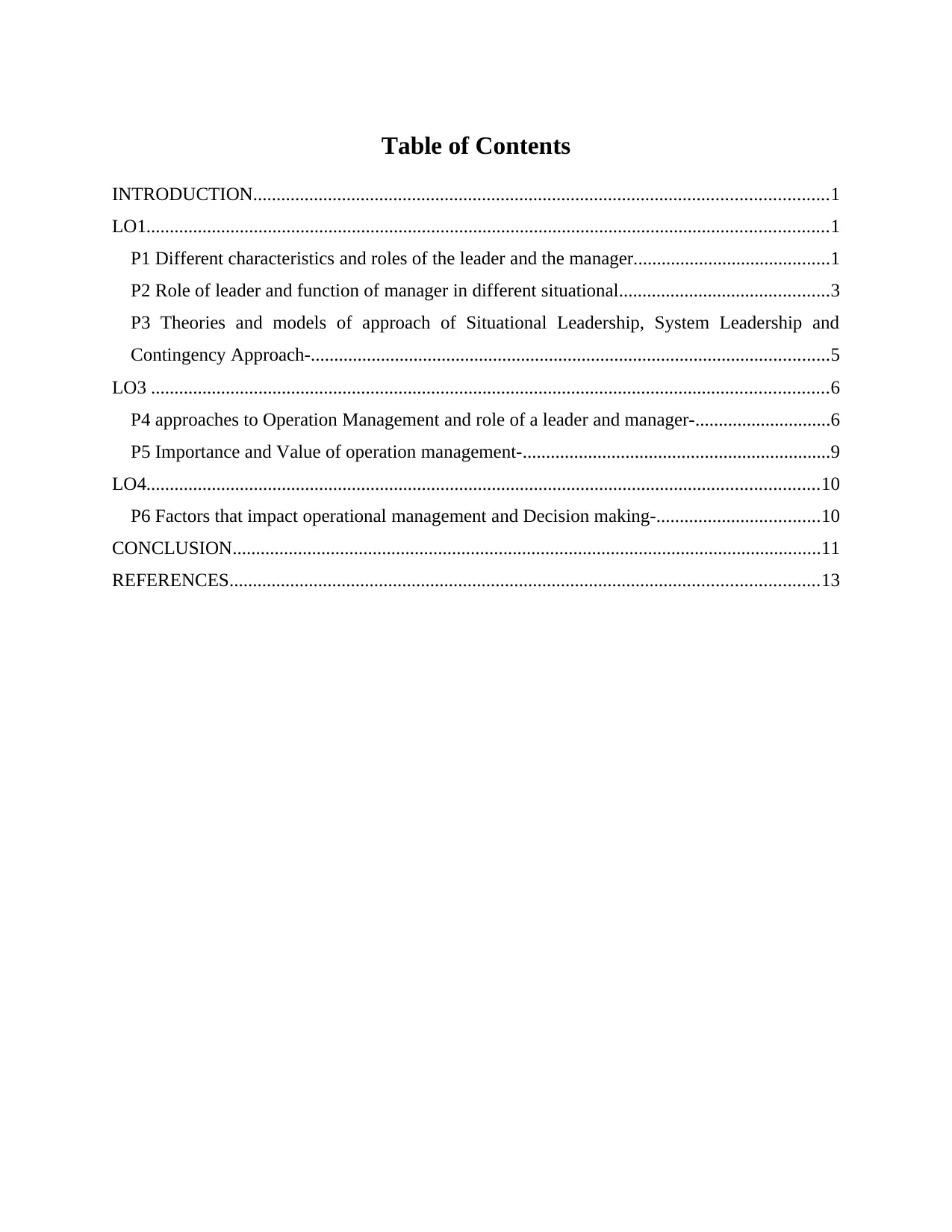
Table of Contents
INTRODUCTION...........................................................................................................................1
LO1..................................................................................................................................................1
P1 Different characteristics and roles of the leader and the manager..........................................1
P2 Role of leader and function of manager in different situational.............................................3
P3 Theories and models of approach of Situational Leadership, System Leadership and
Contingency Approach-...............................................................................................................5
LO3 .................................................................................................................................................6
P4 approaches to Operation Management and role of a leader and manager-.............................6
P5 Importance and Value of operation management-..................................................................9
LO4................................................................................................................................................10
P6 Factors that impact operational management and Decision making-...................................10
CONCLUSION..............................................................................................................................11
REFERENCES..............................................................................................................................13
INTRODUCTION...........................................................................................................................1
LO1..................................................................................................................................................1
P1 Different characteristics and roles of the leader and the manager..........................................1
P2 Role of leader and function of manager in different situational.............................................3
P3 Theories and models of approach of Situational Leadership, System Leadership and
Contingency Approach-...............................................................................................................5
LO3 .................................................................................................................................................6
P4 approaches to Operation Management and role of a leader and manager-.............................6
P5 Importance and Value of operation management-..................................................................9
LO4................................................................................................................................................10
P6 Factors that impact operational management and Decision making-...................................10
CONCLUSION..............................................................................................................................11
REFERENCES..............................................................................................................................13

INTRODUCTION
Operations management is area of the management concerned that controlling and
designing the procedure of redesigning and production of business operation on production of
services and goods. In this report ASDA company is taken. ASDA is the British retail
supermarket and headquarter is located in Leeds (White, 2016). This report highlights the
Difference between the leader and the manager and the role & function of the manager. Also, it
highlights the different models and theories of approach which include the situational leadership,
contingency and system leadership and key approaches of the operational manager and role that
manager and leader play. The essential & value of the operation of the management for
achieving the objective of the business. Also, the factors in the business environment which
impact upon the decision-making and operation management. In this regard the present report
has been prepared.
LO1
P1 Different characteristics and roles of the leader and the manager.
Leadership has the art of the leader that motivate the group people to act towards the
achiving the common goal. Whereas the manager is responsible for to manage and control the
departments in the ASDA organization
Leader Manager
Leader creates the vision of the company by
seeing the possible things and inspire & engage
the employees to turn towards the vision to
reality(Battaïa and et.al., 2018).
Whereas the manager mainly focus on the
measuring setting and try to achieve the goal of
the ASDA company goal and try to control the
situation that exceed and reach the objective.
Leader is change agent, as the leader are a
proud disputer. Leader make change & know
the all things are working well or not and can
be better for the further or not and also
understand the changes and accept To make
some changes in it.
Manager are mostly stick with the things what
the authorize people are hiring, They just
follow the structures and the procedure and
make sure that it is working properly or not.
Leaders are always unique in nature , as they
always willing be themselves(Meindl, 2016).
Manager are copy, as the manager mimic
behaviors and competencies which they learn
Operations management is area of the management concerned that controlling and
designing the procedure of redesigning and production of business operation on production of
services and goods. In this report ASDA company is taken. ASDA is the British retail
supermarket and headquarter is located in Leeds (White, 2016). This report highlights the
Difference between the leader and the manager and the role & function of the manager. Also, it
highlights the different models and theories of approach which include the situational leadership,
contingency and system leadership and key approaches of the operational manager and role that
manager and leader play. The essential & value of the operation of the management for
achieving the objective of the business. Also, the factors in the business environment which
impact upon the decision-making and operation management. In this regard the present report
has been prepared.
LO1
P1 Different characteristics and roles of the leader and the manager.
Leadership has the art of the leader that motivate the group people to act towards the
achiving the common goal. Whereas the manager is responsible for to manage and control the
departments in the ASDA organization
Leader Manager
Leader creates the vision of the company by
seeing the possible things and inspire & engage
the employees to turn towards the vision to
reality(Battaïa and et.al., 2018).
Whereas the manager mainly focus on the
measuring setting and try to achieve the goal of
the ASDA company goal and try to control the
situation that exceed and reach the objective.
Leader is change agent, as the leader are a
proud disputer. Leader make change & know
the all things are working well or not and can
be better for the further or not and also
understand the changes and accept To make
some changes in it.
Manager are mostly stick with the things what
the authorize people are hiring, They just
follow the structures and the procedure and
make sure that it is working properly or not.
Leaders are always unique in nature , as they
always willing be themselves(Meindl, 2016).
Manager are copy, as the manager mimic
behaviors and competencies which they learn
⊘ This is a preview!⊘
Do you want full access?
Subscribe today to unlock all pages.

Trusted by 1+ million students worldwide
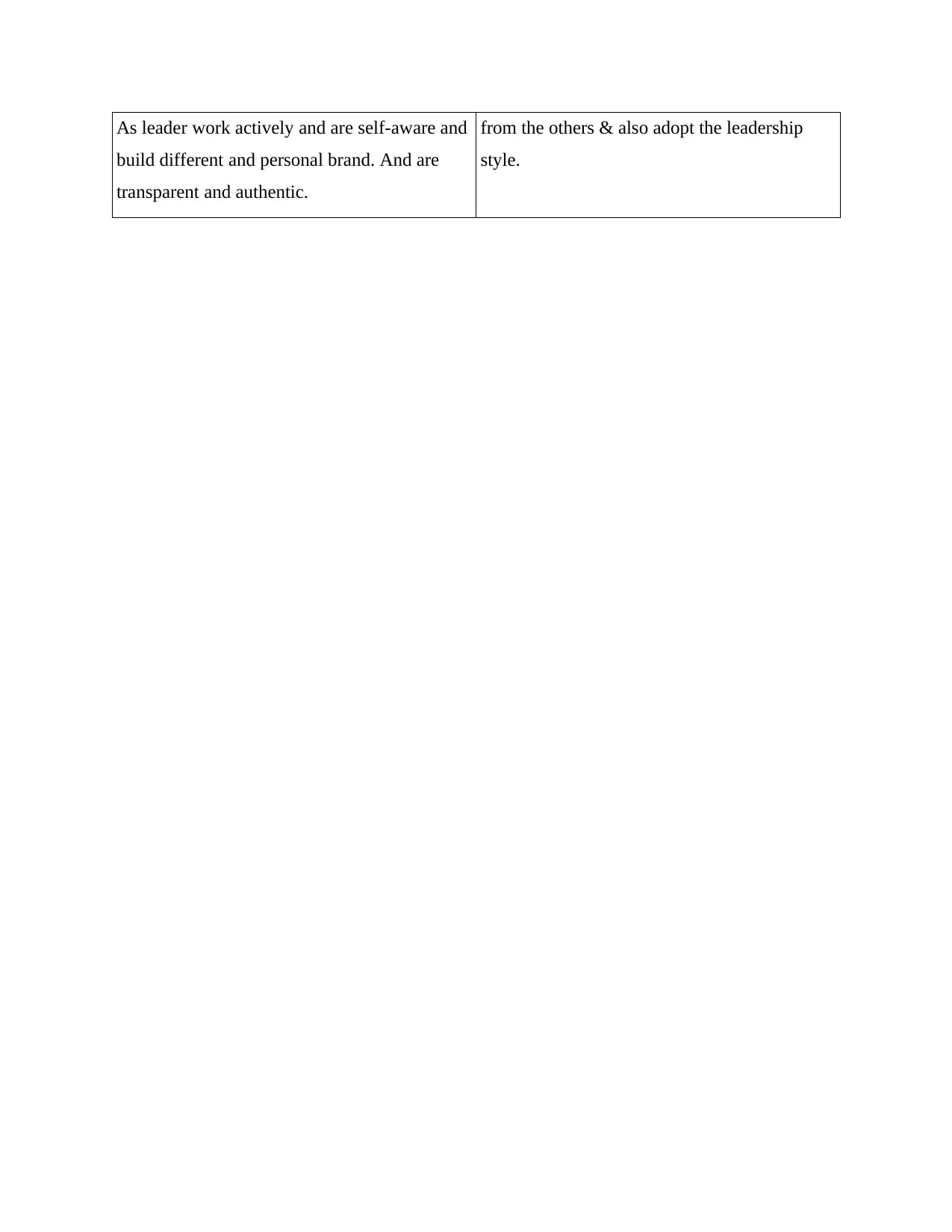
As leader work actively and are self-aware and
build different and personal brand. And are
transparent and authentic.
from the others & also adopt the leadership
style.
build different and personal brand. And are
transparent and authentic.
from the others & also adopt the leadership
style.
Paraphrase This Document
Need a fresh take? Get an instant paraphrase of this document with our AI Paraphraser
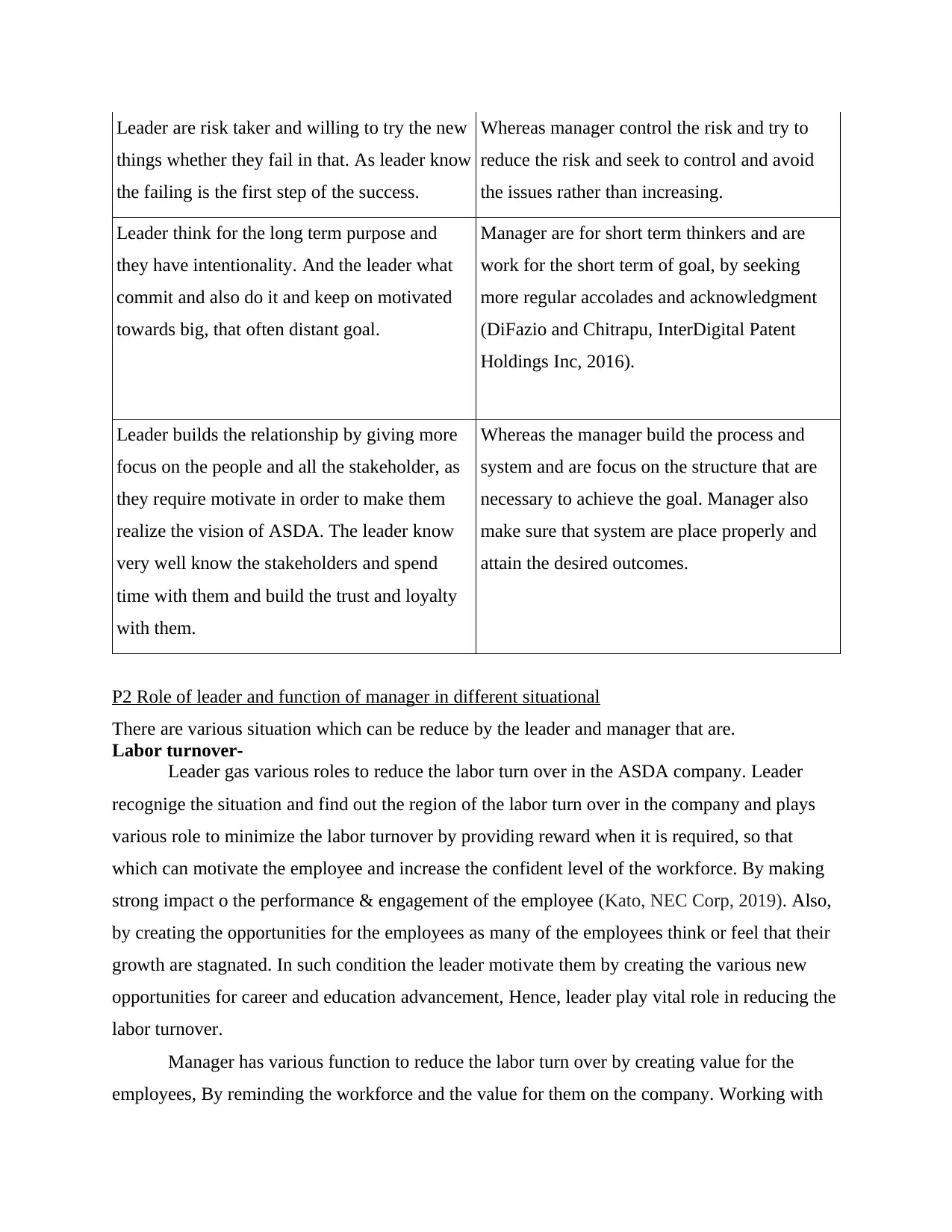
Leader are risk taker and willing to try the new
things whether they fail in that. As leader know
the failing is the first step of the success.
Whereas manager control the risk and try to
reduce the risk and seek to control and avoid
the issues rather than increasing.
Leader think for the long term purpose and
they have intentionality. And the leader what
commit and also do it and keep on motivated
towards big, that often distant goal.
Manager are for short term thinkers and are
work for the short term of goal, by seeking
more regular accolades and acknowledgment
(DiFazio and Chitrapu, InterDigital Patent
Holdings Inc, 2016).
Leader builds the relationship by giving more
focus on the people and all the stakeholder, as
they require motivate in order to make them
realize the vision of ASDA. The leader know
very well know the stakeholders and spend
time with them and build the trust and loyalty
with them.
Whereas the manager build the process and
system and are focus on the structure that are
necessary to achieve the goal. Manager also
make sure that system are place properly and
attain the desired outcomes.
P2 Role of leader and function of manager in different situational
There are various situation which can be reduce by the leader and manager that are.
Labor turnover-
Leader gas various roles to reduce the labor turn over in the ASDA company. Leader
recognige the situation and find out the region of the labor turn over in the company and plays
various role to minimize the labor turnover by providing reward when it is required, so that
which can motivate the employee and increase the confident level of the workforce. By making
strong impact o the performance & engagement of the employee (Kato, NEC Corp, 2019). Also,
by creating the opportunities for the employees as many of the employees think or feel that their
growth are stagnated. In such condition the leader motivate them by creating the various new
opportunities for career and education advancement, Hence, leader play vital role in reducing the
labor turnover.
Manager has various function to reduce the labor turn over by creating value for the
employees, By reminding the workforce and the value for them on the company. Working with
things whether they fail in that. As leader know
the failing is the first step of the success.
Whereas manager control the risk and try to
reduce the risk and seek to control and avoid
the issues rather than increasing.
Leader think for the long term purpose and
they have intentionality. And the leader what
commit and also do it and keep on motivated
towards big, that often distant goal.
Manager are for short term thinkers and are
work for the short term of goal, by seeking
more regular accolades and acknowledgment
(DiFazio and Chitrapu, InterDigital Patent
Holdings Inc, 2016).
Leader builds the relationship by giving more
focus on the people and all the stakeholder, as
they require motivate in order to make them
realize the vision of ASDA. The leader know
very well know the stakeholders and spend
time with them and build the trust and loyalty
with them.
Whereas the manager build the process and
system and are focus on the structure that are
necessary to achieve the goal. Manager also
make sure that system are place properly and
attain the desired outcomes.
P2 Role of leader and function of manager in different situational
There are various situation which can be reduce by the leader and manager that are.
Labor turnover-
Leader gas various roles to reduce the labor turn over in the ASDA company. Leader
recognige the situation and find out the region of the labor turn over in the company and plays
various role to minimize the labor turnover by providing reward when it is required, so that
which can motivate the employee and increase the confident level of the workforce. By making
strong impact o the performance & engagement of the employee (Kato, NEC Corp, 2019). Also,
by creating the opportunities for the employees as many of the employees think or feel that their
growth are stagnated. In such condition the leader motivate them by creating the various new
opportunities for career and education advancement, Hence, leader play vital role in reducing the
labor turnover.
Manager has various function to reduce the labor turn over by creating value for the
employees, By reminding the workforce and the value for them on the company. Working with
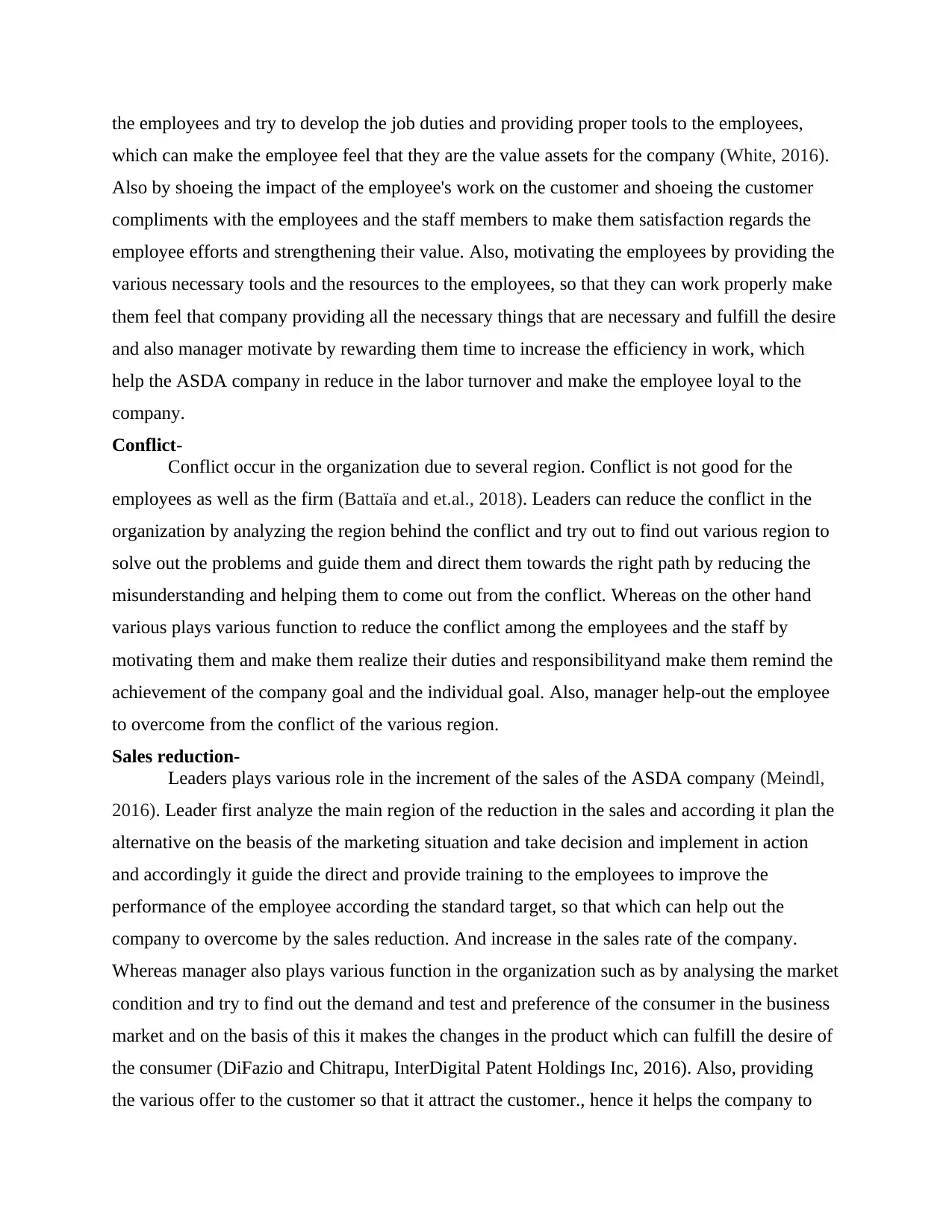
the employees and try to develop the job duties and providing proper tools to the employees,
which can make the employee feel that they are the value assets for the company (White, 2016).
Also by shoeing the impact of the employee's work on the customer and shoeing the customer
compliments with the employees and the staff members to make them satisfaction regards the
employee efforts and strengthening their value. Also, motivating the employees by providing the
various necessary tools and the resources to the employees, so that they can work properly make
them feel that company providing all the necessary things that are necessary and fulfill the desire
and also manager motivate by rewarding them time to increase the efficiency in work, which
help the ASDA company in reduce in the labor turnover and make the employee loyal to the
company.
Conflict-
Conflict occur in the organization due to several region. Conflict is not good for the
employees as well as the firm (Battaïa and et.al., 2018). Leaders can reduce the conflict in the
organization by analyzing the region behind the conflict and try out to find out various region to
solve out the problems and guide them and direct them towards the right path by reducing the
misunderstanding and helping them to come out from the conflict. Whereas on the other hand
various plays various function to reduce the conflict among the employees and the staff by
motivating them and make them realize their duties and responsibilityand make them remind the
achievement of the company goal and the individual goal. Also, manager help-out the employee
to overcome from the conflict of the various region.
Sales reduction-
Leaders plays various role in the increment of the sales of the ASDA company (Meindl,
2016). Leader first analyze the main region of the reduction in the sales and according it plan the
alternative on the beasis of the marketing situation and take decision and implement in action
and accordingly it guide the direct and provide training to the employees to improve the
performance of the employee according the standard target, so that which can help out the
company to overcome by the sales reduction. And increase in the sales rate of the company.
Whereas manager also plays various function in the organization such as by analysing the market
condition and try to find out the demand and test and preference of the consumer in the business
market and on the basis of this it makes the changes in the product which can fulfill the desire of
the consumer (DiFazio and Chitrapu, InterDigital Patent Holdings Inc, 2016). Also, providing
the various offer to the customer so that it attract the customer., hence it helps the company to
which can make the employee feel that they are the value assets for the company (White, 2016).
Also by shoeing the impact of the employee's work on the customer and shoeing the customer
compliments with the employees and the staff members to make them satisfaction regards the
employee efforts and strengthening their value. Also, motivating the employees by providing the
various necessary tools and the resources to the employees, so that they can work properly make
them feel that company providing all the necessary things that are necessary and fulfill the desire
and also manager motivate by rewarding them time to increase the efficiency in work, which
help the ASDA company in reduce in the labor turnover and make the employee loyal to the
company.
Conflict-
Conflict occur in the organization due to several region. Conflict is not good for the
employees as well as the firm (Battaïa and et.al., 2018). Leaders can reduce the conflict in the
organization by analyzing the region behind the conflict and try out to find out various region to
solve out the problems and guide them and direct them towards the right path by reducing the
misunderstanding and helping them to come out from the conflict. Whereas on the other hand
various plays various function to reduce the conflict among the employees and the staff by
motivating them and make them realize their duties and responsibilityand make them remind the
achievement of the company goal and the individual goal. Also, manager help-out the employee
to overcome from the conflict of the various region.
Sales reduction-
Leaders plays various role in the increment of the sales of the ASDA company (Meindl,
2016). Leader first analyze the main region of the reduction in the sales and according it plan the
alternative on the beasis of the marketing situation and take decision and implement in action
and accordingly it guide the direct and provide training to the employees to improve the
performance of the employee according the standard target, so that which can help out the
company to overcome by the sales reduction. And increase in the sales rate of the company.
Whereas manager also plays various function in the organization such as by analysing the market
condition and try to find out the demand and test and preference of the consumer in the business
market and on the basis of this it makes the changes in the product which can fulfill the desire of
the consumer (DiFazio and Chitrapu, InterDigital Patent Holdings Inc, 2016). Also, providing
the various offer to the customer so that it attract the customer., hence it helps the company to
⊘ This is a preview!⊘
Do you want full access?
Subscribe today to unlock all pages.

Trusted by 1+ million students worldwide
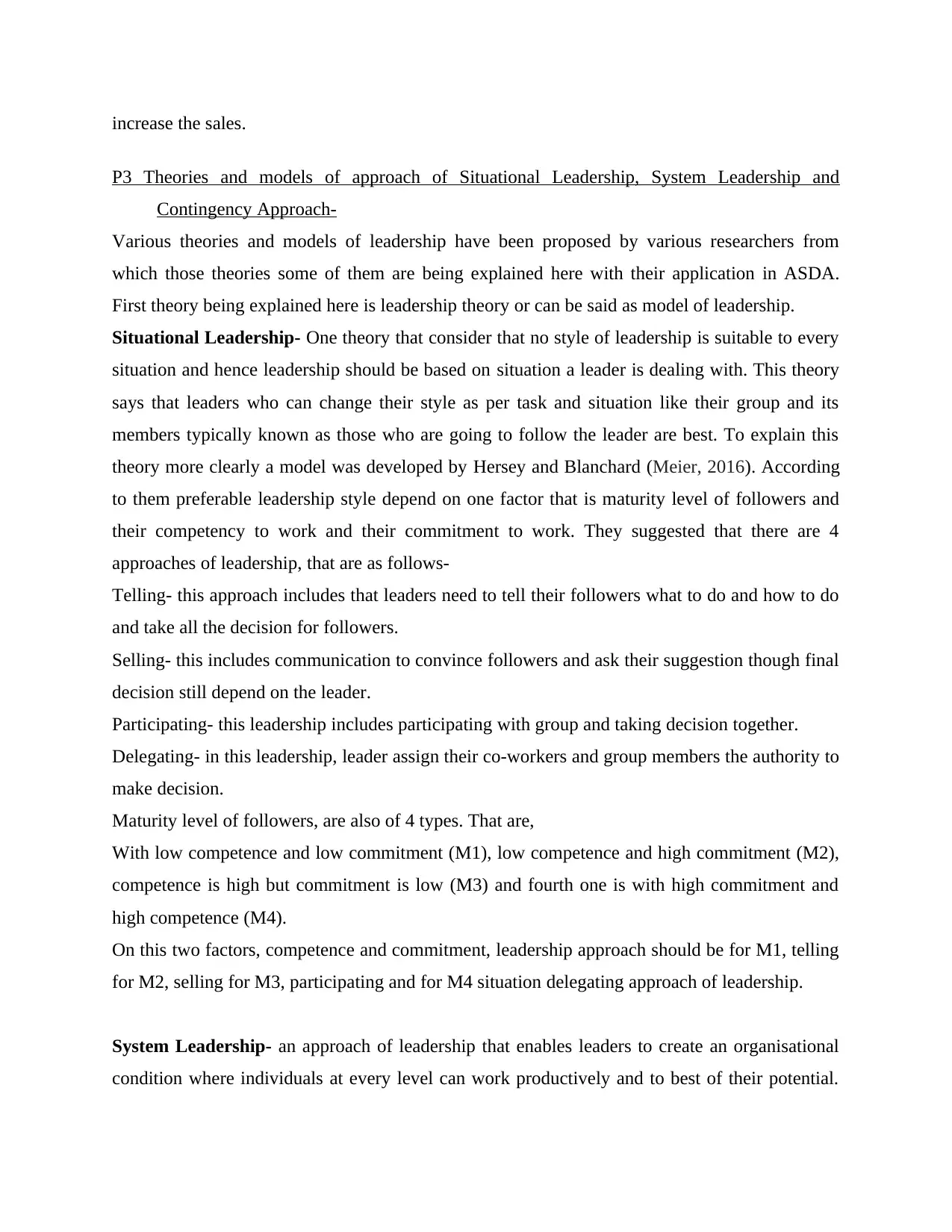
increase the sales.
P3 Theories and models of approach of Situational Leadership, System Leadership and
Contingency Approach-
Various theories and models of leadership have been proposed by various researchers from
which those theories some of them are being explained here with their application in ASDA.
First theory being explained here is leadership theory or can be said as model of leadership.
Situational Leadership- One theory that consider that no style of leadership is suitable to every
situation and hence leadership should be based on situation a leader is dealing with. This theory
says that leaders who can change their style as per task and situation like their group and its
members typically known as those who are going to follow the leader are best. To explain this
theory more clearly a model was developed by Hersey and Blanchard (Meier, 2016). According
to them preferable leadership style depend on one factor that is maturity level of followers and
their competency to work and their commitment to work. They suggested that there are 4
approaches of leadership, that are as follows-
Telling- this approach includes that leaders need to tell their followers what to do and how to do
and take all the decision for followers.
Selling- this includes communication to convince followers and ask their suggestion though final
decision still depend on the leader.
Participating- this leadership includes participating with group and taking decision together.
Delegating- in this leadership, leader assign their co-workers and group members the authority to
make decision.
Maturity level of followers, are also of 4 types. That are,
With low competence and low commitment (M1), low competence and high commitment (M2),
competence is high but commitment is low (M3) and fourth one is with high commitment and
high competence (M4).
On this two factors, competence and commitment, leadership approach should be for M1, telling
for M2, selling for M3, participating and for M4 situation delegating approach of leadership.
System Leadership- an approach of leadership that enables leaders to create an organisational
condition where individuals at every level can work productively and to best of their potential.
P3 Theories and models of approach of Situational Leadership, System Leadership and
Contingency Approach-
Various theories and models of leadership have been proposed by various researchers from
which those theories some of them are being explained here with their application in ASDA.
First theory being explained here is leadership theory or can be said as model of leadership.
Situational Leadership- One theory that consider that no style of leadership is suitable to every
situation and hence leadership should be based on situation a leader is dealing with. This theory
says that leaders who can change their style as per task and situation like their group and its
members typically known as those who are going to follow the leader are best. To explain this
theory more clearly a model was developed by Hersey and Blanchard (Meier, 2016). According
to them preferable leadership style depend on one factor that is maturity level of followers and
their competency to work and their commitment to work. They suggested that there are 4
approaches of leadership, that are as follows-
Telling- this approach includes that leaders need to tell their followers what to do and how to do
and take all the decision for followers.
Selling- this includes communication to convince followers and ask their suggestion though final
decision still depend on the leader.
Participating- this leadership includes participating with group and taking decision together.
Delegating- in this leadership, leader assign their co-workers and group members the authority to
make decision.
Maturity level of followers, are also of 4 types. That are,
With low competence and low commitment (M1), low competence and high commitment (M2),
competence is high but commitment is low (M3) and fourth one is with high commitment and
high competence (M4).
On this two factors, competence and commitment, leadership approach should be for M1, telling
for M2, selling for M3, participating and for M4 situation delegating approach of leadership.
System Leadership- an approach of leadership that enables leaders to create an organisational
condition where individuals at every level can work productively and to best of their potential.
Paraphrase This Document
Need a fresh take? Get an instant paraphrase of this document with our AI Paraphraser
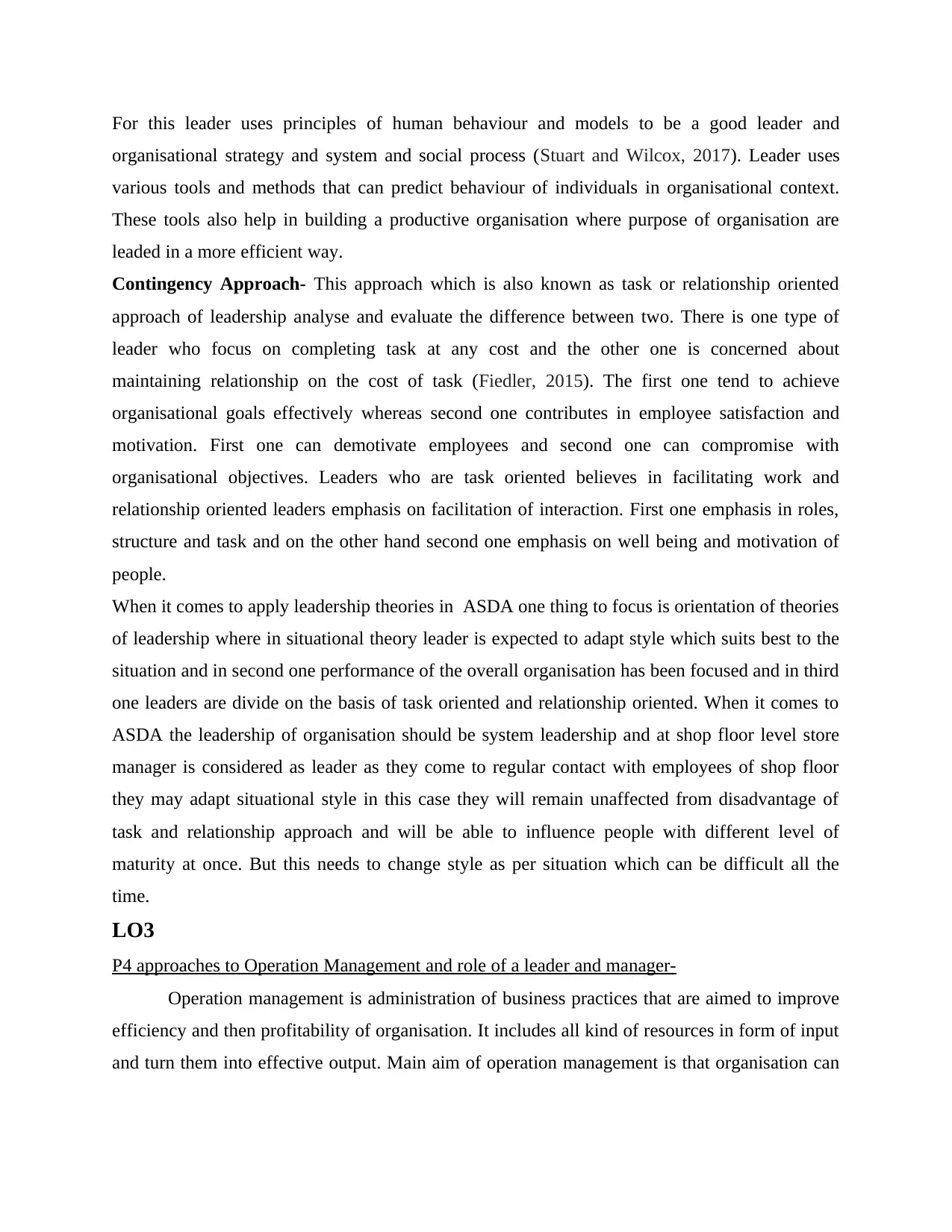
For this leader uses principles of human behaviour and models to be a good leader and
organisational strategy and system and social process (Stuart and Wilcox, 2017). Leader uses
various tools and methods that can predict behaviour of individuals in organisational context.
These tools also help in building a productive organisation where purpose of organisation are
leaded in a more efficient way.
Contingency Approach- This approach which is also known as task or relationship oriented
approach of leadership analyse and evaluate the difference between two. There is one type of
leader who focus on completing task at any cost and the other one is concerned about
maintaining relationship on the cost of task (Fiedler, 2015). The first one tend to achieve
organisational goals effectively whereas second one contributes in employee satisfaction and
motivation. First one can demotivate employees and second one can compromise with
organisational objectives. Leaders who are task oriented believes in facilitating work and
relationship oriented leaders emphasis on facilitation of interaction. First one emphasis in roles,
structure and task and on the other hand second one emphasis on well being and motivation of
people.
When it comes to apply leadership theories in ASDA one thing to focus is orientation of theories
of leadership where in situational theory leader is expected to adapt style which suits best to the
situation and in second one performance of the overall organisation has been focused and in third
one leaders are divide on the basis of task oriented and relationship oriented. When it comes to
ASDA the leadership of organisation should be system leadership and at shop floor level store
manager is considered as leader as they come to regular contact with employees of shop floor
they may adapt situational style in this case they will remain unaffected from disadvantage of
task and relationship approach and will be able to influence people with different level of
maturity at once. But this needs to change style as per situation which can be difficult all the
time.
LO3
P4 approaches to Operation Management and role of a leader and manager-
Operation management is administration of business practices that are aimed to improve
efficiency and then profitability of organisation. It includes all kind of resources in form of input
and turn them into effective output. Main aim of operation management is that organisation can
organisational strategy and system and social process (Stuart and Wilcox, 2017). Leader uses
various tools and methods that can predict behaviour of individuals in organisational context.
These tools also help in building a productive organisation where purpose of organisation are
leaded in a more efficient way.
Contingency Approach- This approach which is also known as task or relationship oriented
approach of leadership analyse and evaluate the difference between two. There is one type of
leader who focus on completing task at any cost and the other one is concerned about
maintaining relationship on the cost of task (Fiedler, 2015). The first one tend to achieve
organisational goals effectively whereas second one contributes in employee satisfaction and
motivation. First one can demotivate employees and second one can compromise with
organisational objectives. Leaders who are task oriented believes in facilitating work and
relationship oriented leaders emphasis on facilitation of interaction. First one emphasis in roles,
structure and task and on the other hand second one emphasis on well being and motivation of
people.
When it comes to apply leadership theories in ASDA one thing to focus is orientation of theories
of leadership where in situational theory leader is expected to adapt style which suits best to the
situation and in second one performance of the overall organisation has been focused and in third
one leaders are divide on the basis of task oriented and relationship oriented. When it comes to
ASDA the leadership of organisation should be system leadership and at shop floor level store
manager is considered as leader as they come to regular contact with employees of shop floor
they may adapt situational style in this case they will remain unaffected from disadvantage of
task and relationship approach and will be able to influence people with different level of
maturity at once. But this needs to change style as per situation which can be difficult all the
time.
LO3
P4 approaches to Operation Management and role of a leader and manager-
Operation management is administration of business practices that are aimed to improve
efficiency and then profitability of organisation. It includes all kind of resources in form of input
and turn them into effective output. Main aim of operation management is that organisation can
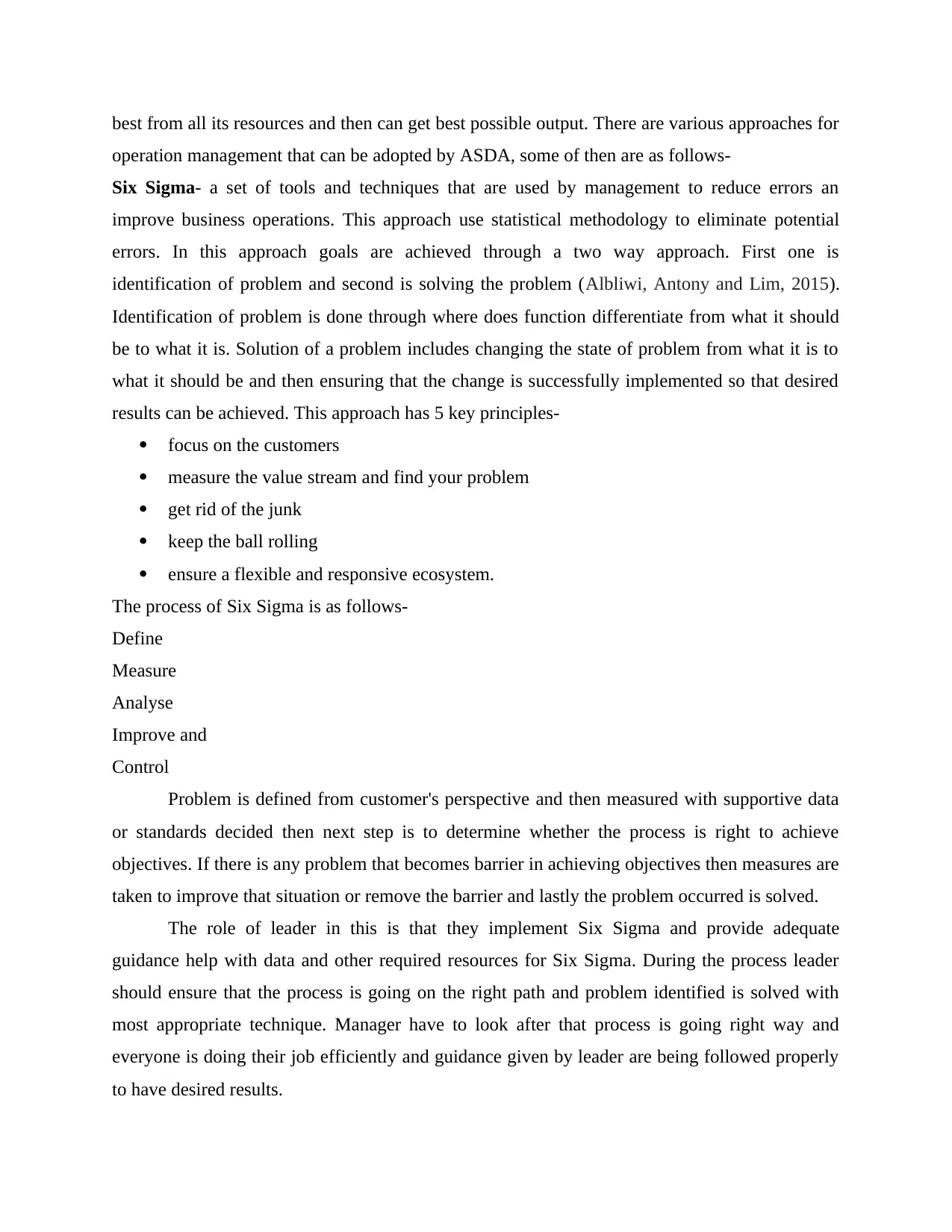
best from all its resources and then can get best possible output. There are various approaches for
operation management that can be adopted by ASDA, some of then are as follows-
Six Sigma- a set of tools and techniques that are used by management to reduce errors an
improve business operations. This approach use statistical methodology to eliminate potential
errors. In this approach goals are achieved through a two way approach. First one is
identification of problem and second is solving the problem (Albliwi, Antony and Lim, 2015).
Identification of problem is done through where does function differentiate from what it should
be to what it is. Solution of a problem includes changing the state of problem from what it is to
what it should be and then ensuring that the change is successfully implemented so that desired
results can be achieved. This approach has 5 key principles-
focus on the customers
measure the value stream and find your problem
get rid of the junk
keep the ball rolling
ensure a flexible and responsive ecosystem.
The process of Six Sigma is as follows-
Define
Measure
Analyse
Improve and
Control
Problem is defined from customer's perspective and then measured with supportive data
or standards decided then next step is to determine whether the process is right to achieve
objectives. If there is any problem that becomes barrier in achieving objectives then measures are
taken to improve that situation or remove the barrier and lastly the problem occurred is solved.
The role of leader in this is that they implement Six Sigma and provide adequate
guidance help with data and other required resources for Six Sigma. During the process leader
should ensure that the process is going on the right path and problem identified is solved with
most appropriate technique. Manager have to look after that process is going right way and
everyone is doing their job efficiently and guidance given by leader are being followed properly
to have desired results.
operation management that can be adopted by ASDA, some of then are as follows-
Six Sigma- a set of tools and techniques that are used by management to reduce errors an
improve business operations. This approach use statistical methodology to eliminate potential
errors. In this approach goals are achieved through a two way approach. First one is
identification of problem and second is solving the problem (Albliwi, Antony and Lim, 2015).
Identification of problem is done through where does function differentiate from what it should
be to what it is. Solution of a problem includes changing the state of problem from what it is to
what it should be and then ensuring that the change is successfully implemented so that desired
results can be achieved. This approach has 5 key principles-
focus on the customers
measure the value stream and find your problem
get rid of the junk
keep the ball rolling
ensure a flexible and responsive ecosystem.
The process of Six Sigma is as follows-
Define
Measure
Analyse
Improve and
Control
Problem is defined from customer's perspective and then measured with supportive data
or standards decided then next step is to determine whether the process is right to achieve
objectives. If there is any problem that becomes barrier in achieving objectives then measures are
taken to improve that situation or remove the barrier and lastly the problem occurred is solved.
The role of leader in this is that they implement Six Sigma and provide adequate
guidance help with data and other required resources for Six Sigma. During the process leader
should ensure that the process is going on the right path and problem identified is solved with
most appropriate technique. Manager have to look after that process is going right way and
everyone is doing their job efficiently and guidance given by leader are being followed properly
to have desired results.
⊘ This is a preview!⊘
Do you want full access?
Subscribe today to unlock all pages.

Trusted by 1+ million students worldwide

Lean Manufacturing- it is approach that focuses on increasing productivity and reducing waste.
In manufacturing systems. This approach is based on principles like Kaizen and continuous
improvement. Benefits of lean manufacturing involves reduced waste, increased productivity,
reduces cost of product, reduces lead time, improved quality of product. Principle of Lean
Manufacturing-
Identify value from customer's perspective
Map the value Stream
Create flow
Establish a pull system
pursue perfection with continuous process improvement.
This includes elimination of following wastes-
excess inventory, unnecessary transportation, unnecessary motion, over production, defects
requiring cost and effort for improving.
In Lean Manufacturing of managers play a key role. They are the one supposed to define
products and process (Bai, Satir and Sarkis, 2019). Then administer everything is going on the
right path and giving mid- process direction as required.
Leader needs to decide objectives and goals for lean manufacturing. What are the things in the
process that requires special attention as per the need of organisational culture. All organisation
and their processes are different one thing that is included in process of one manufacturing
process may not be in other one.
Just-in-time- A new age approach to reduce cost and efforts related to the manufacturing just-in-
time in time states that products should be manufactured whenever they are demanded so that the
cost of storage and efforts in overproduction reduces and quality of the product reduces. It
suggest that pressure on the plant should be adequate neither less nor more. So that cost does not
increase and quality does not decrease.
Manager's role in this approach is to see that plant and resources are available whenever new
demand generates from market (Xu and Chen, 2016). Then to administer the process and look
that it is going correctly without any compromise on quality and cost. The organisation where
this approach is followed organisation needs to be ready all the time so that shortage of product
does not happen. So leader needs to make their organisation and the structure that it is always
ready to take on new demand from market.
In manufacturing systems. This approach is based on principles like Kaizen and continuous
improvement. Benefits of lean manufacturing involves reduced waste, increased productivity,
reduces cost of product, reduces lead time, improved quality of product. Principle of Lean
Manufacturing-
Identify value from customer's perspective
Map the value Stream
Create flow
Establish a pull system
pursue perfection with continuous process improvement.
This includes elimination of following wastes-
excess inventory, unnecessary transportation, unnecessary motion, over production, defects
requiring cost and effort for improving.
In Lean Manufacturing of managers play a key role. They are the one supposed to define
products and process (Bai, Satir and Sarkis, 2019). Then administer everything is going on the
right path and giving mid- process direction as required.
Leader needs to decide objectives and goals for lean manufacturing. What are the things in the
process that requires special attention as per the need of organisational culture. All organisation
and their processes are different one thing that is included in process of one manufacturing
process may not be in other one.
Just-in-time- A new age approach to reduce cost and efforts related to the manufacturing just-in-
time in time states that products should be manufactured whenever they are demanded so that the
cost of storage and efforts in overproduction reduces and quality of the product reduces. It
suggest that pressure on the plant should be adequate neither less nor more. So that cost does not
increase and quality does not decrease.
Manager's role in this approach is to see that plant and resources are available whenever new
demand generates from market (Xu and Chen, 2016). Then to administer the process and look
that it is going correctly without any compromise on quality and cost. The organisation where
this approach is followed organisation needs to be ready all the time so that shortage of product
does not happen. So leader needs to make their organisation and the structure that it is always
ready to take on new demand from market.
Paraphrase This Document
Need a fresh take? Get an instant paraphrase of this document with our AI Paraphraser

P5 Importance and Value of operation management-
Operation management consist of planning, organising and directing daily task of a
manufacturing unit in order too achieve daily task objectives. This approach is concerned mainly
with manufacturing processes. This approach is important for ASDA because of these reasons-
Operation management is important for achieving organisational objectives. Main
objectives in organisation is to increase productivity and reduce cost of product (Reid and
Sanders, 2019). Operation management's main concern is to reduce waste and increase
productivity and this is how it is important in achieving organisational objectives.
Operation management helps in establishing financial efficiency as it reduces spending
on unproductive activities. It will not only reduce cost but will increase profitability in two ways
as cost of the product will be reduces which will attract more customers and the saving because
of not spending money over unproductive activities.
Operational management helps in improving employee performance, through operation
management it becomes easy for employees as what they are required to do and how they need
to do it which help them improving performance and remove ambiguity and daily objectives
keep them motivated to perform.
Goodwill and presence, when organisation enables itself to provide good quality of goods
and services at low cost it also enables itself to create its presence in market and at the same time
improves goodwill that contribute in attracting more customers towards product of organisation.
Operation management helps in winning over competitors, now a days most of the
business organisation compete over their price and quality and operational management ensures
that products of the organisation have a better quality and less price than competitors and this
allows organisation to not just compete in market but also stay ahead from competitors.
Operational management allows organisation to use its resources to their best potential,
this resources can be technology, human resources, materials and other physical resources that a
organisation possess.
One thing that all the business aim to achieve is customer satisfaction and operational
management allows to achieve customer satisfaction by providing qualitative products with less
price.
Along with these importance operational management also add value to the following
factors of ASDA. That are as follows-
Operation management consist of planning, organising and directing daily task of a
manufacturing unit in order too achieve daily task objectives. This approach is concerned mainly
with manufacturing processes. This approach is important for ASDA because of these reasons-
Operation management is important for achieving organisational objectives. Main
objectives in organisation is to increase productivity and reduce cost of product (Reid and
Sanders, 2019). Operation management's main concern is to reduce waste and increase
productivity and this is how it is important in achieving organisational objectives.
Operation management helps in establishing financial efficiency as it reduces spending
on unproductive activities. It will not only reduce cost but will increase profitability in two ways
as cost of the product will be reduces which will attract more customers and the saving because
of not spending money over unproductive activities.
Operational management helps in improving employee performance, through operation
management it becomes easy for employees as what they are required to do and how they need
to do it which help them improving performance and remove ambiguity and daily objectives
keep them motivated to perform.
Goodwill and presence, when organisation enables itself to provide good quality of goods
and services at low cost it also enables itself to create its presence in market and at the same time
improves goodwill that contribute in attracting more customers towards product of organisation.
Operation management helps in winning over competitors, now a days most of the
business organisation compete over their price and quality and operational management ensures
that products of the organisation have a better quality and less price than competitors and this
allows organisation to not just compete in market but also stay ahead from competitors.
Operational management allows organisation to use its resources to their best potential,
this resources can be technology, human resources, materials and other physical resources that a
organisation possess.
One thing that all the business aim to achieve is customer satisfaction and operational
management allows to achieve customer satisfaction by providing qualitative products with less
price.
Along with these importance operational management also add value to the following
factors of ASDA. That are as follows-
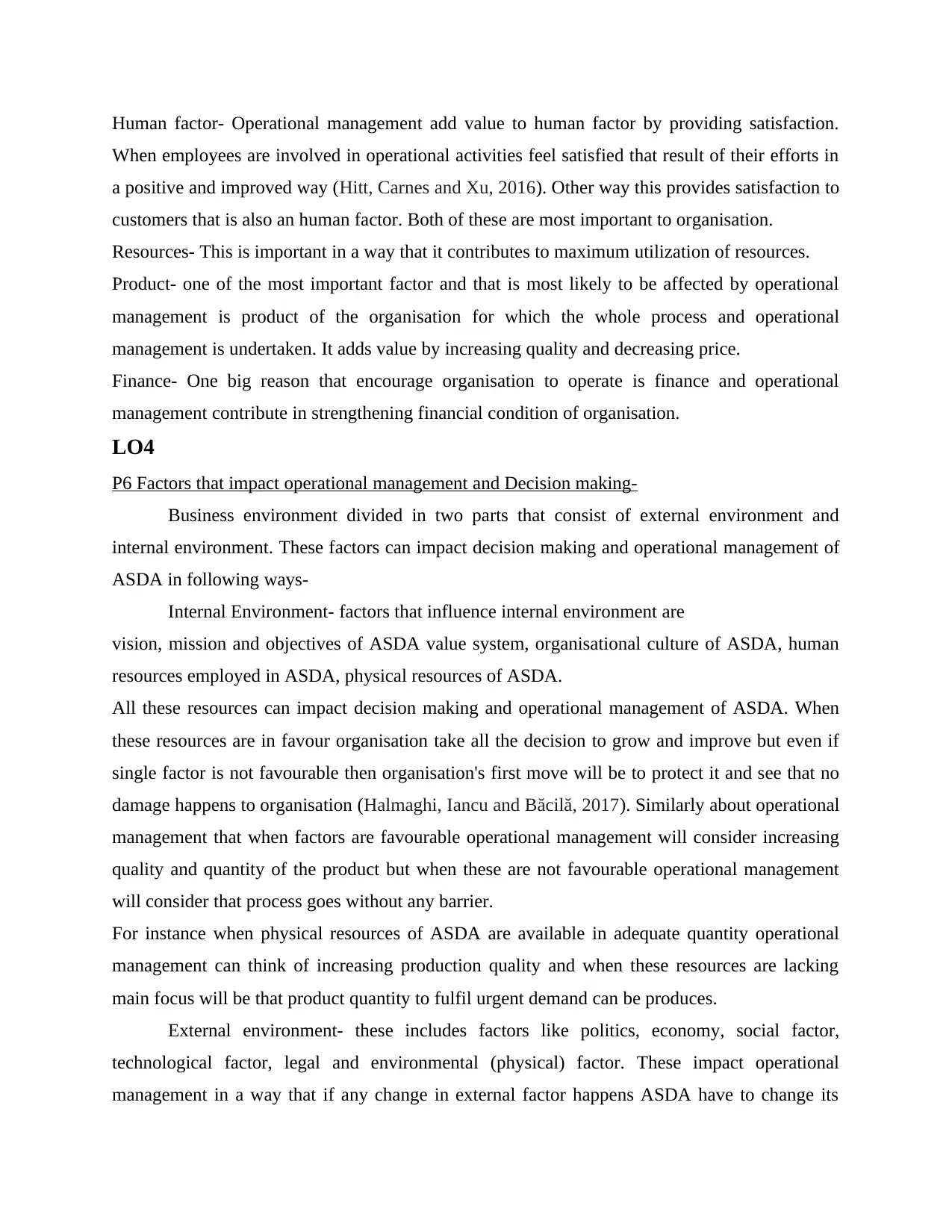
Human factor- Operational management add value to human factor by providing satisfaction.
When employees are involved in operational activities feel satisfied that result of their efforts in
a positive and improved way (Hitt, Carnes and Xu, 2016). Other way this provides satisfaction to
customers that is also an human factor. Both of these are most important to organisation.
Resources- This is important in a way that it contributes to maximum utilization of resources.
Product- one of the most important factor and that is most likely to be affected by operational
management is product of the organisation for which the whole process and operational
management is undertaken. It adds value by increasing quality and decreasing price.
Finance- One big reason that encourage organisation to operate is finance and operational
management contribute in strengthening financial condition of organisation.
LO4
P6 Factors that impact operational management and Decision making-
Business environment divided in two parts that consist of external environment and
internal environment. These factors can impact decision making and operational management of
ASDA in following ways-
Internal Environment- factors that influence internal environment are
vision, mission and objectives of ASDA value system, organisational culture of ASDA, human
resources employed in ASDA, physical resources of ASDA.
All these resources can impact decision making and operational management of ASDA. When
these resources are in favour organisation take all the decision to grow and improve but even if
single factor is not favourable then organisation's first move will be to protect it and see that no
damage happens to organisation (Halmaghi, Iancu and Băcilă, 2017). Similarly about operational
management that when factors are favourable operational management will consider increasing
quality and quantity of the product but when these are not favourable operational management
will consider that process goes without any barrier.
For instance when physical resources of ASDA are available in adequate quantity operational
management can think of increasing production quality and when these resources are lacking
main focus will be that product quantity to fulfil urgent demand can be produces.
External environment- these includes factors like politics, economy, social factor,
technological factor, legal and environmental (physical) factor. These impact operational
management in a way that if any change in external factor happens ASDA have to change its
When employees are involved in operational activities feel satisfied that result of their efforts in
a positive and improved way (Hitt, Carnes and Xu, 2016). Other way this provides satisfaction to
customers that is also an human factor. Both of these are most important to organisation.
Resources- This is important in a way that it contributes to maximum utilization of resources.
Product- one of the most important factor and that is most likely to be affected by operational
management is product of the organisation for which the whole process and operational
management is undertaken. It adds value by increasing quality and decreasing price.
Finance- One big reason that encourage organisation to operate is finance and operational
management contribute in strengthening financial condition of organisation.
LO4
P6 Factors that impact operational management and Decision making-
Business environment divided in two parts that consist of external environment and
internal environment. These factors can impact decision making and operational management of
ASDA in following ways-
Internal Environment- factors that influence internal environment are
vision, mission and objectives of ASDA value system, organisational culture of ASDA, human
resources employed in ASDA, physical resources of ASDA.
All these resources can impact decision making and operational management of ASDA. When
these resources are in favour organisation take all the decision to grow and improve but even if
single factor is not favourable then organisation's first move will be to protect it and see that no
damage happens to organisation (Halmaghi, Iancu and Băcilă, 2017). Similarly about operational
management that when factors are favourable operational management will consider increasing
quality and quantity of the product but when these are not favourable operational management
will consider that process goes without any barrier.
For instance when physical resources of ASDA are available in adequate quantity operational
management can think of increasing production quality and when these resources are lacking
main focus will be that product quantity to fulfil urgent demand can be produces.
External environment- these includes factors like politics, economy, social factor,
technological factor, legal and environmental (physical) factor. These impact operational
management in a way that if any change in external factor happens ASDA have to change its
⊘ This is a preview!⊘
Do you want full access?
Subscribe today to unlock all pages.

Trusted by 1+ million students worldwide
1 out of 15
Related Documents
Your All-in-One AI-Powered Toolkit for Academic Success.
+13062052269
info@desklib.com
Available 24*7 on WhatsApp / Email
![[object Object]](/_next/static/media/star-bottom.7253800d.svg)
Unlock your academic potential
Copyright © 2020–2025 A2Z Services. All Rights Reserved. Developed and managed by ZUCOL.





